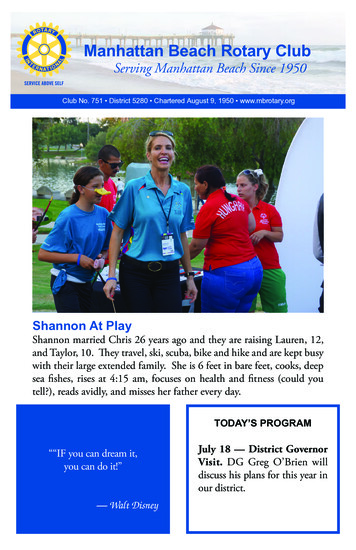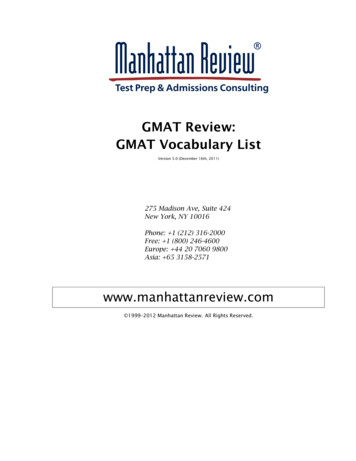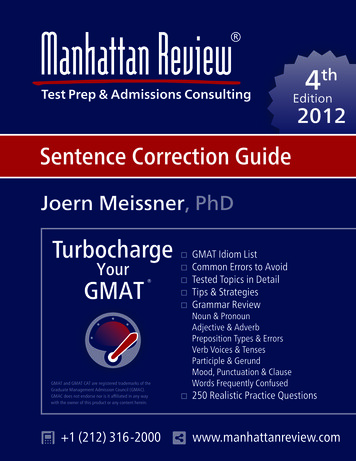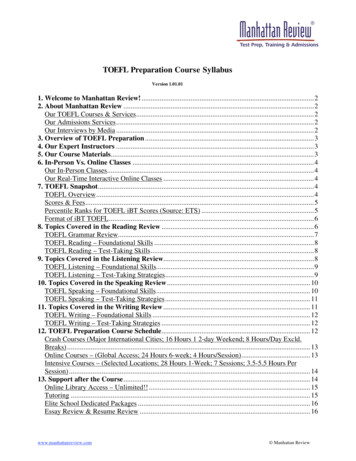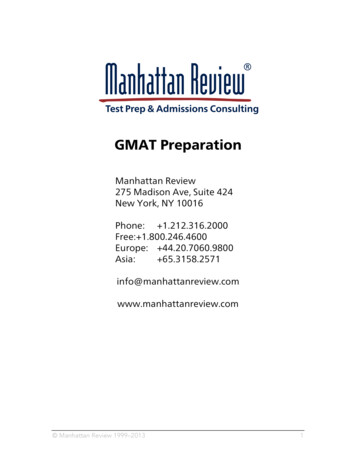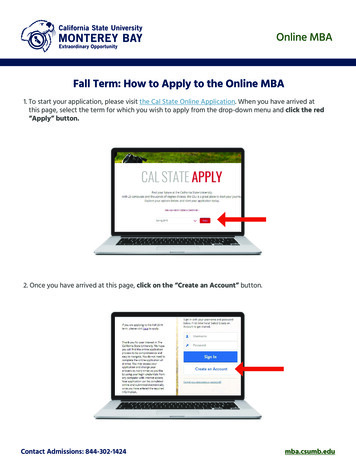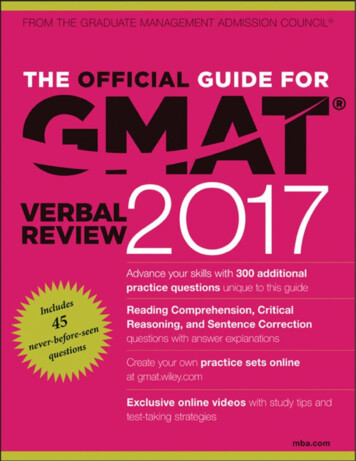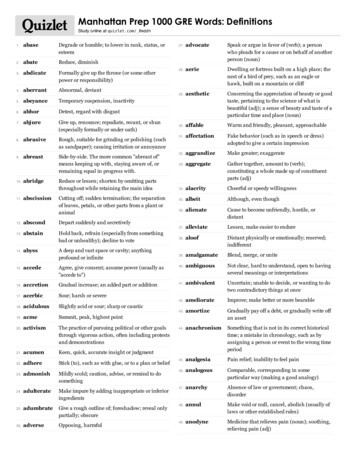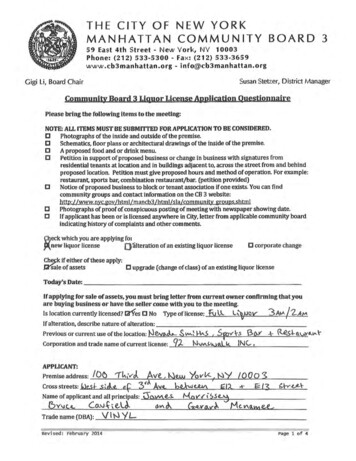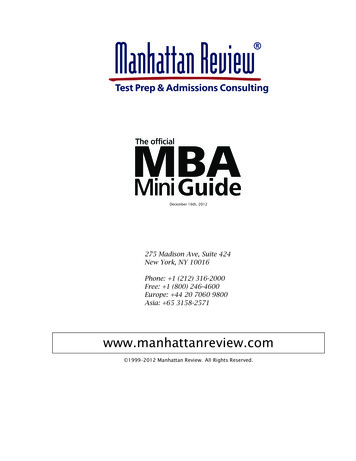
Transcription
The officialMBAMini GuideDecember 16th, 2012275 Madison Ave, Suite 424New York, NY 10016Phone: 1 (212) 316-2000Free: 1 (800) 246-4600Europe: 44 20 7060 9800Asia: 65 3158-2571www.manhattanreview.com 1999–2012 Manhattan Review. All Rights Reserved.
iiThe official MBA Mini GuideCopyright and Terms of UseCopyright and TrademarkAll materials herein (including names, terms, trademarks, designs, images and graphics) arethe property of Manhattan Review, except where otherwise noted. Except as permitted herein,no such material may be copied, reproduced, displayed or transmitted or otherwise used without the prior written permission of Manhattan Review. You are permitted to use materialherein for your personal, non-commercial use, provided that you do not combine such material into a combination, collection or compilation of material. If you have any questionsregarding the use of the material, please contact Manhattan Review at info@manrev.com.This material may make reference to countries and persons. The use of such references is forhypothetical and demonstrative purposes only.ÊTerms of UseBy using this material, you acknowledge and agree to the terms of use contained herein.No WarrantiesThis material is provided without warranty, either express or implied, including the impliedwarranties of merchantability, of fitness for a particular purpose and non-infringement. Manhattan Review does not warrant or make any representations regarding the use, accuracy orresults of the use of this material.Ê This material may make reference to other source materials. Manhattan Review is not responsible in any respect for the content of such other sourcematerials, and disclaims all warranties and liabilities with respect to the other source materials.Limitation on LiabilityManhattan Review shall not be responsible under any circumstances for any direct, indirect,special, punitive or consequential damages (“Damages”) that may arise from the use of thismaterial. In addition, Manhattan Review does not guarantee the accuracy or completeness ofits course materials, which are provided “as is” with no warranty, express or implied. Manhattan Review assumes no liability for any Damages from errors or omissions in the material,whether arising in contract, tort or otherwise.GMAT is a registered trademark of the Graduate Management Admission Council.GMAC does not endorse nor is it affiliated in any way with the owner of this product or anycontent herein.Last updated on December 16, 2012.Manhattan Review, 275 Madison Avenue, Suite 424, New York, NY 10025.Phone: 1 (212) 316-2000. E-Mail: info@manhattanreview.com. Web: www.manhattanreview.comwww.manhattanreview.com 1999–2012 Manhattan Review
The official MBA Mini GuideiiiAbout the Turbocharge your GMAT SeriesThe highly acclaimed Turbocharge Your GMAT series is the result of the arduous effort of Manhattan Review to offer the most comprehensive and clear treatment of theconcepts tests in the GMAT. The Manhattan Review Turbocharge Your GMAT preparation materials include over 600 pages of well-illustrated and professionally presentedstrategies and originally written problems for both the Verbal Section and Quantitative Section, 200 pages of detailed solutions, and more than 300 pages of internallydeveloped Quantitative Glossary and Verbal Vocabulary List with detailed definitions,related words and sentence examples. The detailed breakdown of exclusive practiceproblems per category is 40 Reading Comprehension passages, 60 Critical Reasoningquestions, 250 Sentence Correction questions, and 300 Quantitative questions.Manhattan Review uses this material when delivering its weekend crash courses, oneweek intensive courses, weekday and weekend long courses, online workshops, freeseminars, and private tutoring to students in the US, UK, Continental Europe, Asia andthe rest of the world. Please visit www.manhattanreview.com to find out more and alsotake a free GMAT practice test! Math Study Guide (ISBN: 978-1-62926-000-6)Math Study Companion (ISBN: 978-1-62926-001-3)Verbal Study Guide (ISBN: 978-1-62926-002-0)Verbal Study Companion (ISBN: 978-1-62926-003-7) 1999–2012 Manhattan Reviewwww.manhattanreview.com
ivThe official MBA Mini GuideAbout the CompanyManhattan Review’s origin can be traced directly to an Ivy-League MBA classroom in1999. While lecturing on advanced quantitative subjects to MBAs at Columbia BusinessSchool in New York City, Prof. Dr. Joern Meissner was asked by his students to assisttheir friends, who were frustrated with conventional GMAT preparation options. Hestarted to create original lectures that focused on presenting the GMAT content in acoherent and concise manner rather than a download of voluminous basic knowledgeinterspersed with so-called “tricks." The new approach immediately proved highly popular with GMAT students, inspiring the birth of Manhattan Review. Over the past 15 years, Manhattan Review has grown into a multi-national firm, focusing on GMAT, GRE,LSAT, SAT, and TOEFL test prep and tutoring, along with business school, graduateschool and college admissions consulting, application advisory and essay editing services.About the FounderProfessor Joern Meissner, the founder and chairman of Manhattan Review has overtwenty-five years of teaching experience in undergraduate and graduate programs atprestigious business schools in the USA, UK and Germany. He created the originallectures, which are constantly updated by the Manhattan Review Team to reflect theevolving nature of the GMAT GRE, LSAT, SAT, and TOEFL test prep and private tutoring.Professor Meissner received his Ph.D. in Management Science from Graduate School ofBusiness at Columbia University (Columbia Business School) in New York City and is arecognized authority in the area of Supply Chain Management (SCM), Dynamic Pricingand Revenue Management. Currently, he holds the position of Full Professor of Supply Chain Management and Pricing Strategy at Kuehne Logistics University in Hamburg,Germany. Professor Meissner is a passionate and enthusiastic teacher. He believes thatgrasping an idea is only half of the fun; conveying it to others makes it whole. Athis previous position at Lancaster University Management School, he taught the MBACore course in Operations Management and originated three new MBA Electives: Advanced Decision Models, Supply Chain Management, and Revenue Management. He hasalso lectured at the University of Hamburg, the Leipzig Graduate School of Management(HHL), and the University of Mannheim. Professor Meissner offers a variety of ExecutiveEducation courses aimed at business professionals, managers, leaders, and executiveswho strive for professional and personal growth. He frequently advises companiesranging from Fortune 500 companies to emerging start-ups on various issues relatedto his research expertise. Please visit his academic homepage www.meiss.com for further information.www.manhattanreview.com 1999–2012 Manhattan Review
The official MBA Mini GuidevManhattan Review Advantagesñ Time Efficiency and Cost Effectiveness– The most limiting factor in test preparation for most people is time.– It takes significantly more teaching experience and techniques to prepare astudent in less time.– Our preparation is tailored for busy professionals. We will teach you whatyou need to know in the least amount of time.ñ High-quality and dedicated instructors who are committed to helping everystudent reach her/his goalsñ Manhattan Review’s team members have combined wisdom of– Academic achievements– MBA teaching experience at prestigious business schools in the US and UK– Career successñ Our curriculum & proprietary Turbocharge Your GMAT course materials– About 600 pages of well-illustrated and professionally presented strategiesand exclusive problems for both the Verbal and the Quantitative Sections– 200 pages of detailed solutions– 300-page of internally developed Quantitative and Verbal vocabulary list withdetailed definitions, related words and sentence examples– Challenging Online CATs (Included in any course payments; Available for separate purchases)ñ Combine with Private Tutoring for an individually tailored study packageñ Special Offer for Our Online Recording Library (Visit Online Library on ourwebsite)ñ High-quality Career, MBA & College Advisory Full Serviceñ Our Pursuit of Excellence in All Areas of Our ServiceVisit us often at www.ManhattanReview.com.(Select International Locations for your local content!) 1999–2012 Manhattan Reviewwww.manhattanreview.com
viThe official MBA Mini GuideInternational Phone Numbers & Official Manhattan Review WebsitesManhattan HeadquartersUSA & CanadaAustraliaAustriaBelgiumChinaCzech RepublicFranceGermanyGreeceHong eSouth AfricaSouth KoreaSwedenSpainSwitzerlandTaiwanThailandUnited Arab EmiratesUnited KingdomRest of Worldwww.manhattanreview.com 1-212-316-2000 1-800-246-4600 61-3-9001-6618 43-720-115-549 32-2-808-5163 1-212-316-2000 1-212-316-2000 33-1-8488-4204 49-89-3803-8856 1-212-316-2000 852-5808-2704 1-212-316-2000 1-212-316-2000 1-212-316-2000 1-212-316-2000 39-06-9338-7617 81-3-4589-5125 1-212-316-2000 31-20-808-4399 1-212-316-2000 1-212-316-2000 1-212-316-2000 1-212-316-2000 65-3158-2571 1-212-316-2000 1-212-316-2000 1-212-316-2000 34-911-876-504 41-435-080-991 1-212-316-2000 66-6-0003-5529 1-212-316-2000 44-20-7060-9800 w.manhattanreview.com 1999–2012 Manhattan Review
Contents1 GMAT in a Nutshell1.1 Overview of GMAT . . . . . . . . . . . . . . . . . .1.1.1 2012 Changes in Test Administration . .1.1.2 GMAT Sections and Score Distributions1.1.3 Overview of Basic GMAT Concepts . . . .1.2 Key Test-taking and Preparation Strategies . . .1.2.1 Problem Solving . . . . . . . . . . . . . . .1.2.2 Data Sufficiency . . . . . . . . . . . . . . .1.2.3 Sentence Correction . . . . . . . . . . . . .1.2.4 Critical Reasoning . . . . . . . . . . . . . .1.2.5 Reading Comprehension . . . . . . . . . .1.2.6 Analytical Writing Assessment . . . . . .1.2.7 Integrated Reasoning . . . . . . . . . . . .1.2.8 Test Preparation Advice . . . . . . . . . .1.3 Taking the GMAT . . . . . . . . . . . . . . . . . .1.3.1 Schedule Your Test . . . . . . . . . . . . .1.3.2 Test Fee . . . . . . . . . . . . . . . . . . . .1.3.3 On the Test Day . . . . . . . . . . . . . . .1.3.4 Score Report . . . . . . . . . . . . . . . . .1125910121315171819202122222223242 MBA Admissions in a Nutshell2.1 Overview of MBA . . . . . . . . . . . .2.1.1 Why MBA . . . . . . . . . . . .2.1.2 Academic Offerings . . . . . .2.1.3 Pre-MBA Checklist . . . . . . .2.2 Program Types . . . . . . . . . . . . .2.2.1 Traditional Model . . . . . . .2.2.2 Accelerated Programs . . . .2.2.3 Part-Time MBA . . . . . . . . .2.2.4 Dual Degree MBA . . . . . . .2.2.5 Distance Learning . . . . . . .2.3 MBA Programs . . . . . . . . . . . . .2.3.1 US MBA Programs . . . . . . .2.3.2 International MBA Programs2.3.3 MBA Rankings . . . . . . . . .2.4 Application Strategy . . . . . . . . . .27272728303030303132333434343540vii.
viiiThe official MBA Mini Guide2.4.1 Where to Apply . . . . . . . . .2.4.2 When to Apply . . . . . . . . . .2.4.3 Program Materials . . . . . . . .2.4.4 Talking to the Right People . .2.4.5 MBA Books and Forums . . . .2.4.6 Funding Options . . . . . . . . .2.4.7 Women Applying for MBA . . .2.5 MBA Applications . . . . . . . . . . . .2.5.1 Application Form . . . . . . . .2.5.2 Transcripts and Test Scores . .2.5.3 Resume . . . . . . . . . . . . . .2.5.4 Recommendations . . . . . . . .2.5.5 Essays . . . . . . . . . . . . . . .2.5.6 Interview . . . . . . . . . . . . .2.6 Application Techniques . . . . . . . . .2.6.1 Stay Organized . . . . . . . . . .2.6.2 Explore Ideal Candidacy . . . .2.6.3 Tailor Your Approach . . . . . .2.6.4 Evaluate Your Experience . . .2.6.5 Prove Yourself through Essays2.6.6 Ace Your Interview . . . . . . 15253545456575860 1999–2012 Manhattan Review
Chapter 1GMAT in a Nutshell1.1Overview of GMATBusiness School applicants must take the Graduate Management Admissions Test (GMAT).The GMAT is a standardized test delivered in English. Unlike academic grades, whichhave varying significance based on each school’s grading guidelines, the GMAT scoresare based on the same standard for all test takers and they help business schools assess the qualification of an individual against a large pool of applicants with diversepersonal and professional backgrounds. The GMAT scores play a significant role inadmissions decisions since they are more recent than most academic transcripts of anapplicant and they evaluate a person’s verbal, quantitative and writing skills.The GMAT is approximately 4-hour Computer Adaptive Test (CAT) and can be takenat any one of many test centers around the world 5 or 6 days a week. You may takethe GMAT only once every 31 days and no more than five times within any 12-monthperiod. The retest policy applies even if you cancel your score within that time period.All of your scores and cancellations within the last five years will be reported to theinstitutions you designate as score recipients.The GMAT consists of three separately timed sections. GMAT has changed in June’2012.Before June’12, there used to be two 30-minute sub-sections consists of an analyticalwriting task of writing an Argument essay, also known as Analytical Writing Assessment (AWA). After June’2012, there is only one analytical writing task. The secondAWA task, an issue based essay, is changed to Integrated Reasoning section. The remaining two 75-minute sections (Quantitative and Verbal) consist of multiple-choicequestions delivered in a computer-adaptive format. Questions in these sections aredynamically selected as you take the test to stay commensurate with your ability level.Therefore, your test will be unique. Just one question is shown on the screen at a giventime. However, Integrated Reasoning is not computer-adaptive section. It is impossibleto skip a question or go back to a prior question in any section. Each problem needs tobe answered before the next question.In both the Verbal and Math sections, everyone starts out with an average difficultylevel. The difficulty of subsequent questions then increases or decreases based on the1
2The official MBA Mini Guide – GMAT in a Nutshellcorrect or incorrect answers a person submits in the test. For each correct answer yougive, you are given a harder question for each subsequent question and for each incorrect answer you are given an easier question. This process will continue until youfinish the section, at which point the computer will have an accurate assessment ofyour ability level in that subject area.Your score is determined by three factors: 1) the number of questions you complete; 2)the number of questions you answer correctly and; 3) the level of difficulty and otherstatistical characteristics of each question. To derive a final score, these questions areweighted based on their difficulty and other statistical properties, not their position inthe test.For the AWA section, one person and one computer programmed for grading (E-rater)score the essay based on essay content, organization, grammar and syntactic variety.Your final, single score is an average of both individual cores obtained on the argumentessay. In the Integrated Reasoning section, there are 12 questions. The IR score rangefrom 1-8 with an an interval of 1 point. AWA score and Integrated Reasoning score arecomputed separately from other sections and have no effect on the Verbal, Quantitative, or Total score.The scores necessary to get into top schools are increasing year by year. Studies indicate that applicants who prepare for the GMAT score substantially higher than thosewho don’t. In addition to the admissions process, GMAT scores are also considered injob recruitments and scholarship awards. A good GMAT score can save you thousandsof dollars in tuition. Disciplined and dedicated preparation for the GMAT will allowyou to get the best score possible on the exam and get into the school of your choice.Although the GMAT score is considered as a reasonable indicator of future academicperformance at business schools, it does not measure your job performance, knowledge of business, interpersonal skills, and personality traits such as motivation andcreativity. Instead, your application, essays, recommendation letters and interviewswill capture most of those aspects.Student Notes:1.1.12012 Changes in Test AdministrationAs stated earlier that in the year 2012, GMAC has ushered in a major change in thetest content of the GMAT with the introduction of Integrated Reasoning sub-section inplace of Issue based essay AWA task.Since year 2006, Pearson VUE administering the GMAT, but GMAC, the owner of thewww.manhattanreview.com 1999–2012 Manhattan Review
The official MBA Mini Guide – GMAT in a Nutshell3GMAT, will still be responsible for setting the standards for the exam itself includingformat, question types, difficulty levels, adaptive design, etc.This partnership between the GMAC and Pearson VUE provides: A broader test center network (more than 400 locations in nearly 82 countries)with biometrically enhanced equipment On-line score report which ensures a reliable, timely, and efficient approach toboth test takers and admissions offices (Hard copy of score report is availableupon request) Improved overall customer service, in particular, secure on-line test registrationworldwideWe have summarized and prioritized the key changes affecting the test taker as follows:You can take the GMAT only ONCE every 31 days.The old rule allowed people to take the exam first on March 31st and again on April1st, as the criterion was “once per calendar month”. Now you are permitted to take thetest only once every 31 days.Though we generally recommend our students to ace the test on their first try, it iswise to leave yourself some scheduling flexibility for a second attempt if necessary.Schedule your GMAT 5 to 6 weeks prior to your application deadline.A note: If you receive a perfect score of 800, you may not retake the exam for
years, Manhattan Review has grown into a multi-national firm, focusing on GMAT, GRE, LSAT, SAT, and TOEFL test prep and tutoring, along with business school, graduate school and college admissions consulting, applicatio
